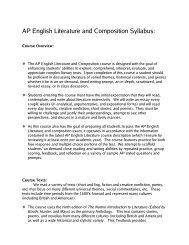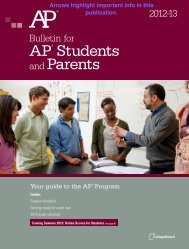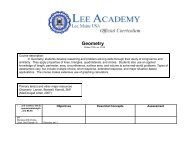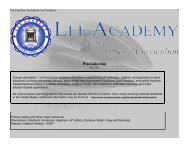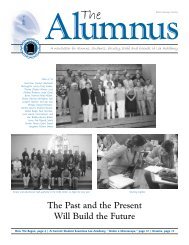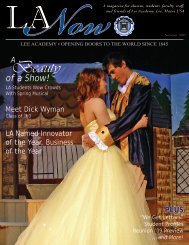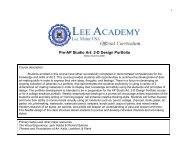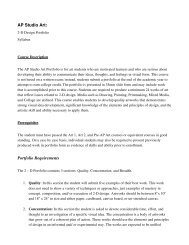Introduction to Drama - Lee Academy
Introduction to Drama - Lee Academy
Introduction to Drama - Lee Academy
Create successful ePaper yourself
Turn your PDF publications into a flip-book with our unique Google optimized e-Paper software.
<strong>Introduction</strong> <strong>to</strong> <strong>Drama</strong><br />
Course Description:<br />
<strong>Introduction</strong> <strong>to</strong> <strong>Drama</strong> is an entry level course designed <strong>to</strong> develop skills and abilities needed <strong>to</strong> express ideas and feelings in the performing<br />
arts. This is a participa<strong>to</strong>ry class in which acting techniques that enhance voice, characterization and movement are explored in depth. Analysis<br />
of theatrical scripts and their stylistic deviations from other forms of written works is examined. Students will learn skills and techniques related <strong>to</strong><br />
the application of the basic elements of technical theatre, including makeup, costuming, lighting, sound, and set design. A culminating activity for<br />
the year consists of an original one act children's play in which all elements of acting and technical theatre are brought <strong>to</strong>gether in a formal<br />
production.<br />
Significant resources for this course include:<br />
Theatre Brief Version, 5 th edition, Robert Cohen, Mayfield Publishing Company<br />
The Physical Comedy Handbook, Robinson, Heinemann Publishing Company<br />
Improvisational Starters, Bernardini, Betterway Books<br />
One-Hundred-Eleven, One-Minute Monologues, Dabrowski, Smith & Kraus Incorporated<br />
Literature Alive, Gamble & Gamble, National Textbook Company<br />
(Video is used <strong>to</strong> show models of costuming, make-up, and set design— e.g. episodes of Face Off from His<strong>to</strong>ry Channel for make-up, Beauty<br />
and the Beast for costuming, and In<strong>to</strong> the Woods for set design.)<br />
1
MLRs,<br />
Unit Name and Length<br />
http://www.maine.gov/education/lres/c<br />
ontent.html<br />
Objectives Essential Questions Assessments<br />
Unit 1 Two weeks<br />
<strong>Introduction</strong> <strong>to</strong> the<br />
Theatre and Stage<br />
E5a: Getting along with<br />
others<br />
E5c: Working as a<br />
team/ensemble<br />
B3: Students improvise<br />
through theatre games<br />
Student will:<br />
—become comfortable while<br />
performing in front of an<br />
audience.<br />
—learn <strong>to</strong> work collaboratively in<br />
small groups.<br />
—learn <strong>to</strong> share ideas and<br />
compromise within the group<br />
setting.<br />
What theatre techniques ( games,<br />
warm ups and improvisations) aid an<br />
ac<strong>to</strong>r in achieving comfort on the<br />
stage?<br />
What is the role of “ensemble acting”<br />
in the theatre?<br />
Students will participate in a series of<br />
get acquainted/warm up activities.<br />
Group consensus activity<br />
Unit 2 Three weeks<br />
The Ac<strong>to</strong>r's Mind<br />
C1: Students apply and<br />
analyze creative thinking<br />
skills <strong>to</strong> improve their<br />
own work.<br />
One of the three essential <strong>to</strong>ols of<br />
an ac<strong>to</strong>r, student will:<br />
—learn how the mind dictates<br />
memorization, characterization<br />
and stage focus.<br />
What techniques aid in script<br />
memorization?<br />
How does memory recall aid in<br />
development of a character?<br />
What concentration skills help in<br />
focusing while on stage?<br />
Students participate in memory<br />
enhancing activities, including<br />
“chunking” and “concentration”.<br />
Stunts perform in short skits with a<br />
focus on memory recall.<br />
Of what value is creative thinking<br />
during the acting process?<br />
Unit 3 Three weeks<br />
The Ac<strong>to</strong>r's Body<br />
The second essential <strong>to</strong>ol of an<br />
ac<strong>to</strong>r, student will;<br />
—learn how movement, both<br />
How does body awareness enhance<br />
both internal and external character<br />
development?<br />
Students perform mime skits.<br />
Students perform in “body talk” and<br />
2
B1: Students refine<br />
gesture and stage<br />
business in the portrayal<br />
of a role.<br />
B2: Students<br />
demonstrate<br />
development of<br />
character using<br />
...physicality <strong>to</strong><br />
communicate ideas,<br />
moods, intentions,<br />
and/or feelings.<br />
large and small, dictates<br />
character personality and<br />
psychology.<br />
How do broad gestures help create a<br />
character?<br />
How does subtlety of movement<br />
define a character?<br />
How do ac<strong>to</strong>r's “become” a character?<br />
“body walk” improvisations.<br />
Mirror Mirror Quiz.<br />
Students create character-driven<br />
improvs based on physicality.<br />
Unit 4 Three weeks<br />
The Ac<strong>to</strong>r's Voice<br />
B2:Students demonstrate<br />
development of a<br />
character using voice<br />
timing, voice<br />
<strong>to</strong>ne/level...<strong>to</strong><br />
communicate ideas,<br />
moods, intentions,<br />
and/or feelings.<br />
The third <strong>to</strong>ol of an ac<strong>to</strong>r, student<br />
will:<br />
—learn how the voice enhances<br />
character development and stage<br />
presence.<br />
How do pitch, diction, emphasis,<br />
rhythm, and pauses aid in character<br />
development?<br />
How do correct breathing techniques<br />
enhance a performance?<br />
Students participate in a series of<br />
breathing exercises designed <strong>to</strong> “free<br />
their voice”.<br />
Students perform “Jabberwocky” in<br />
small groups.<br />
Original Tongue Twisters are created<br />
and performed.<br />
Students explore unique voices from<br />
the stage and screen.<br />
Unit 5 Five weeks<br />
The Ac<strong>to</strong>r's<br />
Imagination<br />
B3: Students improvise<br />
Student will:<br />
—discover how imagination acts<br />
as the foundation of all theatrical<br />
activities.<br />
How is imagination an integral part of<br />
childhood game playing?<br />
How can we harness early childhood<br />
imagination in adulthood?<br />
Students create original “games”<br />
based on childhood activities.<br />
“A Doll's Tale” s<strong>to</strong>ry telling technique.<br />
3
through theatre games.<br />
E5c: Students work as a<br />
team/ensemble.<br />
What role does imagination play in the<br />
creative process?<br />
Setting/character/conflict<br />
improvisation.<br />
Unit 6 Four weeks<br />
<strong>Introduction</strong> <strong>to</strong><br />
Technical Theatre<br />
A1: Students identify and<br />
define the parts of the<br />
stage.<br />
A2: Students create and<br />
use theatre props,<br />
costumes, makeup, and<br />
stage pieces.<br />
A2c: Develop specific<br />
light and sound cues.<br />
Student will:<br />
—learn the basics of stage<br />
terminology and direction.<br />
—demonstrate an understanding<br />
of fundamental stage makeup<br />
and costuming techniques.<br />
—understand the role of set<br />
design in the overall production.<br />
What is the role of a stagehand or<br />
tech person in the overall production?<br />
What are the individual tasks of the<br />
set designer, makeup artist, costume<br />
designer, and lighting direc<strong>to</strong>r?<br />
How do differing makeup techniques<br />
work <strong>to</strong> create believable characters?<br />
Quiz over stage<br />
terminology/directions.<br />
Students will create monster, fairytale<br />
and classic characters, utilizing<br />
makeup and costuming techniques.<br />
In small groups, students will design<br />
sets for the upcoming musical,<br />
including lighting cues and props.<br />
Unit 7 Six weeks<br />
Script Analysis<br />
A1: Students identify and<br />
describe the crisis,<br />
resolution and theme of<br />
a play.<br />
D1a: Students analyze,<br />
interpret and evaluate<br />
art forms.<br />
Student will:<br />
—read, analyze and interpret two<br />
full length scripts; one a musical<br />
and one a drama.<br />
—compare and contrast style,<br />
theme, characterization, and plot<br />
in two plays.<br />
What stylistic differences and<br />
similarities exist in a dramatic three<br />
act play and a musical?<br />
One page compare/contrast essay.<br />
4
Unit 8 Three weeks<br />
Monologues<br />
A2d: Participate in the<br />
audition process.<br />
E5e:<br />
Accepting/giving/using<br />
constructive feedback.<br />
E5h: Following<br />
established rules for<br />
observing/listening <strong>to</strong><br />
art.<br />
Ci: Students apply and<br />
analyze creative thinking<br />
skills... <strong>to</strong> improve the<br />
work of others<br />
Student will:<br />
—choose, rehearse and present a<br />
three minute monologue in front<br />
of the class.<br />
What is the role of the monologue in<br />
the audition process?<br />
What are the special features of a<br />
monologue versus an ensemble piece?<br />
What must be the ac<strong>to</strong>r's<br />
considerations in a monologue?<br />
How do previously learned concepts<br />
such as memorization, focus and<br />
improvisation play a role in the<br />
successful monologue?<br />
Monologue rehearsal and<br />
presentation.<br />
Individual student analysis of<br />
performances utilizing a class created<br />
rubric.<br />
Unit 9 Five weeks<br />
Final Production<br />
A2a: Apply technical<br />
knowledge and skills <strong>to</strong><br />
collaboratively create/use<br />
props, costumes,<br />
makeup, and stage<br />
pieces.<br />
A2c: Develop specific<br />
light and sound cues and<br />
use them in scene<br />
Student will:<br />
—work as part of an ensemble in<br />
the creation of a one act<br />
children's theatre production <strong>to</strong><br />
be performed at local elementary<br />
schools<br />
—experience the complete<br />
production from pre-show<br />
through strike.<br />
—utilize previously learned<br />
concepts in voice, imagination<br />
and movement in the creation of<br />
How do the components of technical<br />
theatre and acting come <strong>to</strong>gether in a<br />
production?<br />
How do the technical aspects of the<br />
theatre help <strong>to</strong> enhance the ac<strong>to</strong>r's<br />
portrayal of a character?<br />
What previously learned techniques<br />
work well for the individual ac<strong>to</strong>r in<br />
shaping a character?<br />
Students create costumes, sets,<br />
makeup, lighting,sound effects, and<br />
props for a production.<br />
Students complete a questionnaire<br />
focusing on character development.<br />
Children's Theatre rehearsal and<br />
performance.<br />
5
development.<br />
B1: Students refine<br />
gesture and stage<br />
business in a role.<br />
B2: Students<br />
demonstrate<br />
development of a<br />
character's attitude and<br />
pov using voice and<br />
physicality <strong>to</strong><br />
communicate ideas,<br />
moods and intentions.<br />
believable, vivid characters.<br />
6



